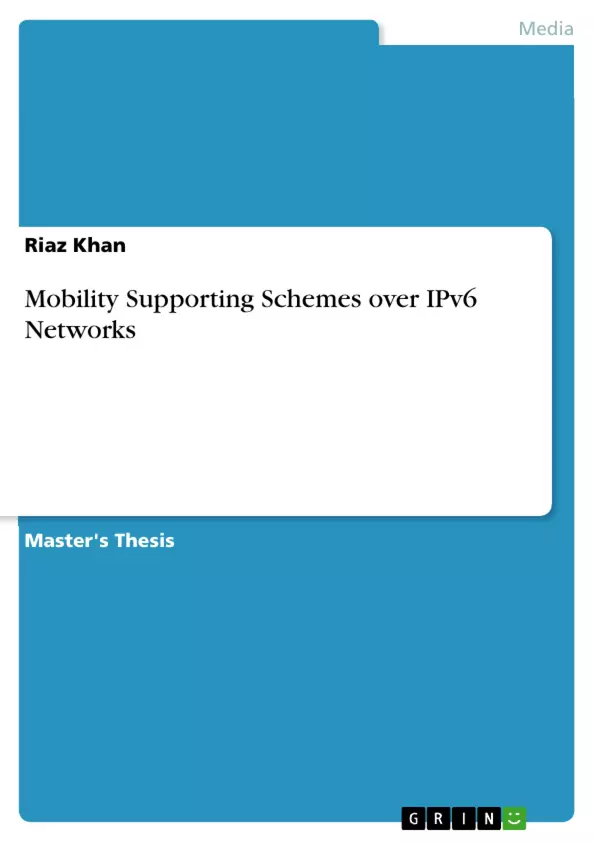The study provides quantitative results of the performance improvements obtained by new enhancements as observed by a single mobile user with respect to handoff latency, throughput, packet delivery ratio, average jitter etc. In addition to this, the signaling load costs associated with the performance improvements provided by the enhancements has been analyzed. The handover delay reduction approaches, specifically the Fast Handover Mobile Ipv6 FHMIPv6 have been shown. The thesis concludes with the analysis of simulation results, evaluating the MIPv6, HMIPv6 and FHMIPv6 performance and finally gives some suggestions for the future work.
Mobile Internet Protocol (MIP), the current International Engineering Task Force (IETF) proposal for IP mobility support, represents a key element for future all-Internet Protocol (IP) wireless networks to provide service continuity while on the move within a multi-access environment. A performance evaluation of Mobile internet protocol version 6 (IPv6) and its proposed enhancements, that is Fast Handovers for Mobile IPv6, Hierarchical Mobile IPv6 was conducted. And a combination of fast handover (FMIPv6) and hierarchical mobile IPv6 (HMIPv6) was proposed and simulated by using the network simulator NS-2. The simulation scenario comprised two access routers and one mobile node that communicated in accordance with the IEEE 802.11 wireless LAN standards.
Inhaltsverzeichnis (Table of Contents)
- CHAPTER 1: INTRODUCTION
- 1.1 Research Motivation
- 1.2 Local and Global Mobility
- 1.3 Host Based Mobility
- 1.4 Mobile IPv6
- 1.5 Hierarchical Structures and Protocols
- 1.6 Hierarchical Mobile IPv6
- 1.7 FHMIPv6
- 1.8 Research Objectives
- 1.9 Thesis Outlines
- CHAPTER 2: MOBILE IP PROTOCOL (MIP)
- 2.1 Internet Protocol (IP) Overview
- 2.2 IPv4 Addressing and Sub-Netting
- 2.2.1 Hardware Addressing
- 2.2.2 Logical Addressing
- 2.3 Internet Protocol (IP)
- 2.3.1 IPv4 Addressing
- 2.3.2 IPv6 Addressing
- 2.4 Mobile IP Version 4 (MIPv4)
- 2.5 Mobile IP Version 6 (MIPv6)
- 2.6 Wireless Local Area Network (WLAN)
- CHAPTER 3: LITERATURE SURVEY
- 3.1 Problem Statement
- CHAPTER 4: HANDOVER DELAY
- 4.1 Handover Delay Reasons
- 4.1.1 Standard MIPv6 Handover Delay
- 4.1.2 HMIPv6 Handover Delay
- 4.1.3 FMIPv6 Handover Delay
- 4.1.4 FHMIPv6 Handover Delay
- 4.1 Handover Delay Reasons
- CHAPTER 5: THE SIMULATION
- 5.1 Simulation Goals
- 5.2 Simulation Model
- 5.3 Mobile IP Extension
- 5.3.1 Delay Reduction Extension to NS2
- 5.4 Simulation Scenario
- CHAPTER 6: THE RESULTS
- 6.1 Results at Varying Speed of MN
- 6.2 Results Obtained By Increasing the Simulation Time
- 6.3 Result Analysis
- CHAPTER 7: CONCLUSION AND FUTURE WORK
- 7.1 Conclusion
- 7.2 Future Work
Zielsetzung und Themenschwerpunkte (Objectives and Key Themes)
This thesis explores the performance of various mobility supporting schemes in IPv6 networks, focusing on the challenge of providing seamless connectivity for mobile devices. The main objective is to evaluate and compare the effectiveness of different techniques, particularly Fast Handovers for Mobile IPv6 (FMIPv6) and Hierarchical Mobile IPv6 (HMIPv6), in addressing handover delay and other performance metrics. Key themes of the thesis include: * **Mobility Management in IPv6 Networks:** Investigating solutions for managing mobile devices within the IPv6 framework. * **Handover Latency and Performance Optimization:** Analyzing the impact of handover techniques on network performance, including latency, throughput, and packet delivery ratio. * **Evaluation of MIPv6 Enhancements:** Comparing the performance characteristics of standard MIPv6, HMIPv6, and FMIPv6 to identify the most efficient approaches. * **Simulation and Analysis of Mobility Schemes:** Utilizing network simulation tools like NS-2 to model and analyze the performance of various mobility schemes. * **Signaling Load and Cost Considerations:** Exploring the trade-offs between performance improvements and signaling overhead associated with different mobility schemes.Zusammenfassung der Kapitel (Chapter Summaries)
* **Chapter 1: Introduction:** Introduces the concept of mobility in IPv6 networks and outlines the research motivation behind this thesis. It explores the challenges of providing seamless connectivity to mobile devices and the limitations of traditional IP mobility schemes. * **Chapter 2: Mobile IP Protocol (MIP):** This chapter provides a comprehensive overview of the Internet Protocol (IP), its evolution from IPv4 to IPv6, and the fundamental principles of Mobile IP. It delves into the details of Mobile IP version 4 (MIPv4) and Mobile IP version 6 (MIPv6), outlining the core concepts and mechanisms for mobility support. * **Chapter 3: Literature Survey:** This chapter reviews existing research and literature related to mobile IP and handover techniques in IPv6 networks. It identifies key problems, challenges, and existing solutions, setting the context for the research presented in this thesis. * **Chapter 4: Handover Delay:** This chapter focuses on handover delay, a critical performance metric in mobile networks. It discusses the causes of handover delay in various mobility schemes, including standard MIPv6, HMIPv6, and FMIPv6. * **Chapter 5: The Simulation:** This chapter describes the simulation setup and methodology used to evaluate the performance of different mobility schemes. It explains the simulation model, the use of NS-2 as a simulation tool, and the specific scenarios used for testing. * **Chapter 6: The Results:** This chapter presents the results obtained from the simulation experiments. It analyzes the performance of different mobility schemes in terms of handover latency, throughput, packet delivery ratio, and other relevant metrics. * **Chapter 7: Conclusion and Future Work:** This chapter summarizes the key findings of the thesis, highlighting the relative performance of different mobility schemes. It discusses the implications of the results and suggests potential avenues for future research.Schlüsselwörter (Keywords)
This thesis focuses on the critical domain of mobile networking with a particular emphasis on IPv6. Key areas of exploration include mobile IP, handover delay, performance optimization, network simulation, and the evaluation of different mobility schemes like FMIPv6 and HMIPv6. The research investigates the impact of these schemes on critical performance indicators such as handover latency, throughput, and packet delivery ratio. This comprehensive analysis aims to contribute to the advancement of robust and efficient mobility solutions for IPv6 networks.- Arbeit zitieren
- Riaz Khan (Autor:in), 2012, Mobility Supporting Schemes over IPv6 Networks, München, GRIN Verlag, https://www.grin.com/document/376247



